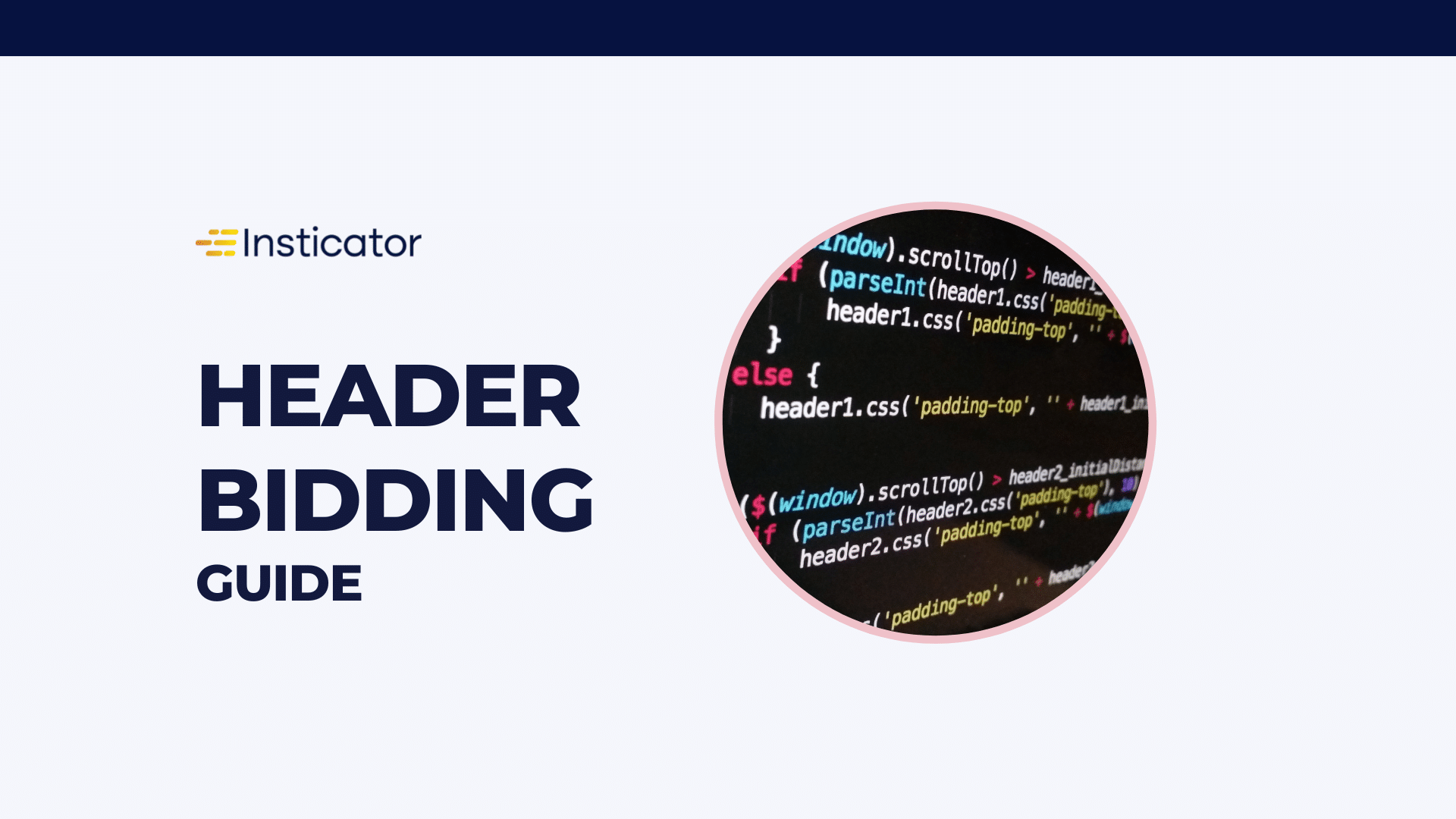Header Bidding – Everything a Publisher Should Know
January 2023
#Monetization

Publishers are constantly searching for ways to increase their ad revenue. By innovating new strategies and maximizing existing ones, they’re able to capitalize on the best methods available to them.
One of those methods is header bidding.
Header bidding allows publishers to showcase their ad inventory to multiple demand partners, which creates competition and ultimately increases their ad revenue. The process involves using JavaScript to build a header bidding wrapper, which allows advertisers to target their ads more effectively.
Table of Contents
In this article, we learn more about header bidding and how it become one of the most valued techs in the ad tech world.
What is Header Bidding?
Header bidding is a technique used by digital publishers to increase ad revenue by allowing multiple demand partners to bid on ad inventory simultaneously.
This creates competition among advertisers and results in higher bids for the publisher.
The process involves using JavaScript to build a header bidding wrapper, which allows advertisers to target their ads more effectively by eliminating inefficiencies such as Google AdX’s preferential bid position when a publisher uses Google’s ad server.
In short, it is a way to run an auction for ad inventory in real time before sending a request to the ad server.
Why AdTech Needed Header Bidding?
Before header bidding came into the industry, the publishers used the waterfall method to sell the ad inventory to buyers.
The waterfall method sold ad inventory in a sequential way – starting with the first buyer in the list and then moving down to the last one. There were two major problems with this:
1. The first buyer was not always the high paying one. Hence, publishers were unable to get the best and highest bid for their ad inventory.
2. It was time-consuming. If the first buyer rejected the inventory, it will go to the next buyer, and so on. Hence, most times publishers were unable to show ads because buyers were taking too long to place the bid.
How Does Header Bidding Help Publishers?
Header bidding helps publishers increase ad revenue by allowing multiple demand partners to bid on ad inventory simultaneously, rather than in sequential order. This creates competition among advertisers, which results in higher bids for the publisher.
Here are the benefits of Header Bidding for publishers:
Increased ad revenue: Header bidding allows multiple demand partners to bid on ad inventory simultaneously, resulting in higher bids for the publisher.
Fair and transparent auction process: Header bidding eliminates inefficiencies such as Google AdX’s preferential bid position when a publisher uses Google’s ad server, providing a fair and transparent auction process.
Better control over ad inventory: Publishers have more control over the ad inventory and the demand partners they work with, resulting in more targeted and relevant advertising for their users.
Improved user experience: By providing more targeted and relevant advertising, header bidding can improve the user experience on a publisher’s website.
Reduced latency: Header bidding can reduce latency by allowing the auction process to happen in the header of a webpage before the ad request is sent to the ad server.
Increased viewability: Header bidding can increase viewability by providing more accurate and relevant ads to users.
Greater transparency: Header bidding allows publishers to see all the bids in real-time, which makes it easier to understand how their ad inventory is being valued.
Better demand partner relationships: Header bidding allows publishers to form better relationships with demand partners by giving them more control over the ad inventory and demand partners they work with.
Improved fraud detection: Header bidding allows publishers to detect and prevent fraud by providing more transparency in the auction process.
Greater flexibility: Header bidding gives publishers the flexibility to work with multiple demand partners and ad networks, which can result in more revenue opportunities.
How Does Header Bidding Work?
Header bidding works by allowing multiple demand partners to bid on ad inventory simultaneously. This is done by using JavaScript to build a header bidding wrapper, which is a piece of code that is placed in the header of a publisher’s webpage.
When a user visits the publisher’s website, the header bidding wrapper sends requests to multiple demand partners simultaneously, allowing them to bid on the available ad inventory.
The demand partners then respond with their bid, and the highest bid wins the auction. This allows the publisher to have a fair and transparent auction process with multiple demand partners.
The winning bid is then sent to the ad server, which serves the ad to the user. This process happens in real-time and before the ad request is sent to the ad server, which helps to reduce latency.
Overall, header bidding allows publishers to have more control over their ad inventory and the demand partners they work with, resulting in more targeted and relevant advertising for their users, and ultimately more ad revenue for the publishers.
Read How Header Bidding Works in Detail.
Why Are Demand Partners Important For Header Bidding?
Demand partners are important for header bidding because they provide the bids that determine the value of the ad inventory. Without demand partners, there would be no competition for the ad inventory and the publisher would not be able to increase their ad revenue through header bidding.
Demand partners include ad networks, demand-side platforms (DSPs), and agencies, which represent the advertisers that want to buy ad space on the publisher’s website. They bid on the publisher’s ad inventory in real-time, and the highest bid wins the auction.
Demand partners are important for header bidding because they provide:
Competition: By allowing multiple demand partners to bid on ad inventory simultaneously, header bidding creates competition among demand partners, which results in higher bids for the publisher.
Access to a wide range of demand sources: Header bidding allows publishers to access demand from a wide range of sources, including traditional ad exchanges, supply-side platforms (SSPs), and networks.
Increased targeting: Demand partners can provide more granular targeting options for the ads, which can result in a better user experience.
Better use of ad inventory: By having multiple demand partners bidding on the same inventory, publishers can get a better price for their ad inventory.
Control over demand partners: Header bidding allows publishers to have more control over which demand partners they work with and to monitor their performance.
What is a Header Bidding Wrapper?
A header bidding wrapper is a piece of JavaScript code that is placed in the header of a publisher’s webpage. It is used to facilitate header bidding by allowing multiple demand partners to bid on ad inventory simultaneously.
The wrapper acts as an intermediary between the publisher’s website and the demand partners, it facilitates the communication, the organization, and the management of the bid process.
In short, a header bidding wrapper is a crucial piece of code that enables the functionality of header bidding, allowing publishers to increase their ad revenue and have more control over their ad inventory and demand partners.
Prebid – An Open Source Header Bidding Wrapper
Prebid.js is an open-source JavaScript library that allows publishers to implement header bidding on their websites. It is a client-side header bidding solution that allows multiple demand partners to bid on ad inventory simultaneously, resulting in higher bids for the publisher.
Prebid.js is a popular solution among publishers because it is easy to implement, it is compatible with a wide range of demand partners, and it is free to use. It also provides a range of features and functionalities to improve the header bidding process such as:
Support for multiple ad formats: Prebid.js supports a wide range of ad formats, such as display, native, and video.
Support for multiple ad sizes: Prebid.js allows for the auction to happen for different sizes of ads, which allows for a more efficient use of the ad inventory.
Support for multiple ad units: Prebid.js allows for the auction to happen for different ad units on the same page, which allows for a more efficient use of the ad inventory.
Support for multiple ad devices: Prebid.js allows for the auction to happen for different devices, such as desktop and mobile, which allows for more efficient use of the ad inventory.
Support for multiple ad currencies: Prebid.js allows for the auction to happen in different currencies, which allows for a more efficient use of the ad inventory.
Prebid.js is a widely used solution among publishers because of its flexibility and ease of use, it is also part of the Prebid project, which is a community-driven initiative to improve header bidding.
The prebid project also provides other tools such as Prebid Server and Prebid Mobile which can help publishers to implement and optimize their header bidding process.
What is a Header Bidding Adapter?
A header bidding adapter is a piece of code that connects a demand partner’s bid to a publisher’s header bidding wrapper. It acts as a bridge between the demand partner’s platform and the publisher’s website, allowing the demand partner to participate in the header bidding process.
The adapter receives the ad inventory information from the publisher’s website and sends it to the demand partner’s platform. The demand partner’s platform then processes the information and returns a bid to the adapter. The adapter then formats the bid and sends it back to the publisher’s header bidding wrapper.
The header bidding adapter is specific to each demand partner, so a publisher may need to use different adapters for different demand partners. The adapter is responsible for the communication protocol, the format and the data structure of the bid, it must be compatible with the publisher’s header bidding wrapper.
In summary, a header bidding adapter is a code that connects a demand partner’s platform to a publisher’s header bidding wrapper, allowing the demand partner to participate in the header bidding process and enabling the publisher to have more control over the ad inventory and demand partners they work with.
Client-side Header Bidding vs Server-side Header Bidding?
Client-side header bidding and server-side header bidding are two different methods for implementing header bidding on a publisher’s website.
| Client-side Header Bidding | Server-side Header Bidding |
| Client-side header bidding is the more traditional method, where the JavaScript code of the header bidding wrapper is placed directly in the header of the publisher’s website. | Server-side header bidding, on the other hand, involves moving the header bidding process to the publisher’s server. This means that the header bidding wrapper and the adapters are running on the server side, rather than on the user’s browser. |
| This means that all of the biddings takes place on the user’s browser, also known as the client side. | This method can reduce latency and improve page load times, as the bids are collected and processed on the server before the ad request is sent to the ad server. |
| This method is simple to implement and allows for a wide range of demand partners to participate in the header bidding process, but it can slow down the page load time and increase latency. | However, this method can be more complex to implement and may not be compatible with all demand partners. |
In summary, client-side header bidding is the traditional method, where all the bidding takes place on the client side, it’s simpler to implement but it can slow down the page load time.
Server-side header bidding is a more recent method, it takes place on the server side which reduces latency and improves page load time, but it can be more complex to implement.
Client-Side vs. Server-Side Header Bidding: What’s the Difference
Google’s Answer to Header Bidding – Open Bidding
Google Open Bidding (formerly known as Exchange Bidding) is a server-side header bidding solution offered by Google. It is designed to help publishers increase their ad revenue by allowing multiple demand partners to bid on ad inventory simultaneously in a unified auction.
With Google Open Bidding, publishers can send their ad inventory to multiple demand partners at once, rather than sending them one at a time. This creates competition among demand partners and results in higher bids for the publisher. In addition, Open Bidding allows publishers to access demand from a wide range of sources, including traditional ad exchanges, supply-side platforms (SSPs), and networks.
Google Open Bidding also uses a unique auction mechanism called the “unified auction” which allows for a more efficient use of the ad inventory and allows more transparency and fairness in the auction process.
Google Open Bidding also provides a variety of tools and features to help publishers manage their ad inventory, such as the ability to set floor prices, prioritize demand partners, and access detailed reporting.
Google Open Bidding is compatible with a wide range of ad formats, including display, video, and native ads. It also supports a wide range of ad devices such as desktop, mobile, and app.
Open Bidding Vs. Header Bidding: What’s the Difference?
Are There Any Disadvantages of Header Bidding?
Header bidding is a powerful tool for increasing ad revenue and improving the targeting of advertising, but it also has some disadvantages, such as:
Latency: Client-side header bidding can slow down page load times and increase latency, as all of the bidding takes place on the user’s browser.
Complexity: Setting up and implementing header bidding can be complex, especially for publishers who are not familiar with the technology.
Compatibility issues: Some demand partners may not be compatible with a publisher’s header bidding wrapper, which can limit the number of demand partners that can participate in the header bidding process.
Increased data usage: Header bidding can increase the data usage on a user’s device, as all the requests and bids are made on the client side.
Privacy concerns: Header bidding process might collect users’ data in the process of requests and bids, which could raise some privacy concerns for users and regulatory bodies.
Dependence on JavaScript: Header bidding relies on JavaScript, if users have JavaScript disabled, the header bidding process will not work, which can limit the number of users that can be reached by the publisher.
Extra cost: Some demand partners may charge an additional fee for participating in a header bidding process, which can increase the publisher’s costs.
Limited scalability: Header bidding can be limited in terms of scalability, as it requires a lot of server resources and can become a bottleneck if the publisher’s website receives a large amount of traffic.
The Pros and Cons of Header Bidding
Is Video Header Bidding Possible?
Video header bidding is a method for implementing header bidding for video ad inventory. It is similar to traditional header bidding for display ads, but it is specifically designed for video ads. Video header bidding allows multiple demand partners to bid on video ad inventory simultaneously, resulting in higher bids for the publisher.
Video header bidding is typically implemented using a JavaScript library, such as Prebid.js, which allows for easy integration with the publisher’s website and video player. The process works by sending requests to multiple demand partners simultaneously, allowing them to bid on the available video ad inventory. The demand partners then respond with their bid, and the highest bid wins the auction.
Some of the key benefits of video header bidding include increased competition among demand partners, which leads to higher bids for the publisher, and improved targeting of video ads, which results in a better user experience.
Video header bidding also allows for the auction to happen for different ad formats, such as outstream, instream, and linear, and also allows for a more efficient use of the video ad inventory.
It is important to note that video header bidding requires more resources and a more complex setup than display header bidding. It also requires a more sophisticated video player that can handle the video header bidding process. However, it can be a powerful tool for publishers to increase their revenue from video ads and provide more relevant and engaging video content to their users.
How To Get Started With Header Bidding?
Getting started with header bidding can be a complex process, but it can be broken down into a few key steps:
Research: Research the different types of header bidding, including client-side and server-side header bidding, and determine which method is best for your website.
Select demand partners: Identify which demand partners you want to work with and check if they are compatible with your header bidding wrapper.
Implement header bidding wrapper: Integrate the header bidding wrapper into your website’s code.
Set up adapters: Set up adapters for each of the demand partners you want to work with.
Test and optimize: Test the header bidding process on your website and optimize as needed.
Monitor and Analyze: Monitor the performance of your header bidding implementation, analyze the data, and make adjustments accordingly.
Continuously evaluate and improve: Continuously evaluate your header bidding implementation and look for ways to improve it.
It is important to note that the implementation process can be very technical and may require the help of a developer or an ad tech expert. Some publisher-side solutions providers also offer a set of tools that can help publishers to implement, manage and optimize their header bidding implementation.
It is also important to be aware of the regulations and best practices in your country and region, to ensure that your implementation is compliant with them.
Some Well-known Header Bidding Platforms
There are a number of header bidding platforms available, some of the most popular and widely used include:
Prebid.js: An open-source JavaScript library that allows publishers to implement header bidding on their websites, it’s a client-side solution that supports a wide range of ad formats and demand partners.
Google Open Bidding (formerly known as Exchange Bidding): A server-side header bidding solution offered by Google, it allows for a unified auction process and provides a range of tools and features to help publishers manage their ad inventory.
AppNexus: A header bidding platform that offers a wide range of tools and features, including a server-side solution, support for multiple ad formats, and access to a wide range of demand sources.
Amazon Publisher Services: A header bidding platform that offers a wide range of tools and features, including a server-side solution, support for multiple ad formats, and access to a wide range of demand sources.
Criteo: A header bidding platform that offers a wide range of tools and features, including a server-side solution, support for multiple ad formats, and access to a wide range of demand sources.
Index Exchange: A header bidding platform that offers a wide range of tools and features, including a server-side solution, support for multiple ad formats, and access to a wide range of demand sources.
It is important to keep in mind that the best platform for a publisher will depend on their specific needs, goals and the size of their website.
Some publisher-side solutions providers also offer a set of tools that can help publishers to implement, manage and optimize their header bidding process.
How To Find The Right Header Bidding Partners?
Finding the right header bidding partners can be a crucial step in increasing ad revenue and improving the targeting of advertising on your website.
Here are a few steps to help you find the right partners:
Research: Research different demand partners and ad networks that offer header bidding solutions. Look for partners that specialize in your target audience and have a good reputation in the industry.
Identify your goals: Clearly identify your goals for using header bidding and look for partners that align with those goals. For example, to increase your ad revenue, look for partners with a proven track record of driving high bids.
Check compatibility: Check if the demand partners you are interested in working with are compatible with your header bidding wrapper.
Look for partners with a wide range of inventory: Look for partners that can offer a wide range of inventory to bid on, this will increase the chances of finding the best match for your audience.
Read reviews and ask around: Read reviews and ask other publishers about their experiences with different demand partners. This can provide valuable insights and help you avoid any potential issues.
Test and evaluate: Once you’ve found some potential partners, test them out and evaluate their performance. This will help you identify which partners are the best fit for your website and audience.
Set up a whitelist: Set up a whitelist of the partners that have been approved to bid on your ad inventory, this will help you to keep control of the demand partners that have access to your inventory and their performance.
Keep in mind that the demand partners you choose to work with will have a direct impact on the success of your header bidding implementation.
Therefore, take the time to research and find the right partners that align with your goals and are compatible with your website. It is also important to continuously monitor and evaluate the performance of your partners to ensure they are still the right fit.
In Closing
At Insticator, we offer full-ad management service to publishers. This includes managing your ad inventory, setting up header bidding campaigns, and finding you the right demand partners.
If you have any questions, reach out to our experts. Or book a demo to unlock the full potential of your ad earnings.

Written by


